The “Art of Aging” from an ergonomics viewpoint – Wisdoms on age
Abstract
BACKGROUND:
The paper is a printed version of keynotes and plenary addresses which have been presented during international ergonomics conferences to which the author had been invited. It focuses on human work performance influenced by an advanced age. Aging of the workforce, productivity, or work and health, today must be regarded as important research topics for ergonomics and for realizing age-differentiated work design.
OBJECTIVE:
A scientific survey of the various human performance potentials impacted by age.
METHODS:
A comprehensive literature review of scientific papers dealing with age-dependent work performance was carried out. The results were garnished with suitable aphorisms, sentences and wisdoms on age which stem from wise old men and prominent philosophers and poets.
RESULTS:
The results comprise physical age-related performance potentials, e.g., muscle strength and assembly performance. Also the impact of age on vision and on the hearing is described in detail and it is visualized in figures and tables. Furthermore, important age-dependent changes in the central nervous system and in mental-cognitive performance areas are reported. Fortunately, also positive issues of aging on the working performance could be detected. The paper ends with a meditative discourse about length and quality of life.
CONCLUSIONS:
Age-differentiated work design has to be based on specific knowledge about age-dependent performance potentials of the employees. A comprehensive literature review revealed a lot of already existing and sustainable facts which can be applied in work design. However, further fundamental and especially applied research is necessary since today substantial changes in the working conditions occur very quickly.
1.Introduction
When dealing with the topic “The Art of Aging” from an ergonomics viewpoint, special attention has to be given to the aspect of work potential in dependence on age. The survey of the impact of aging on human performance functions is focused on fundamental, unavoidable biological changes which are of relevance for ergonomics. Hereby the not always pleasant facts that will emerge are garnished with some “aphorisms” (e.g., see [1]) which will hopefully encourage people to say “yes” to the course of the working life and to help them accept that some things will be different at an advanced age than people would like them to be. Two statements that are polar opposites, although both contain a kernel of truth, shall represent the starting point of the survey. The first is the popular challenge to “Stay young, even as one gets older” [2]. The second one is a poem that contains much self-awareness. Eugen Roth (1895–1976) – one of the most read lyricists and poets of the 20
• “Wet at birth – a son or daughter – An infant’s made of mainly water, Sucking, drinking, they abound, ‘til baby dries and runs around. And dry he gets – behind the ears – so does his humor, over the years. Alas, the human degrades, yet still lives on for decades.”
This is not exactly an enjoyable outlook since – despite the admittedly humorous exaggeration – changes manifest themselves which will invariably catch up with us at some point in the future. After the initially desirable water losses, it is expected, of course, that the not-so-pleasant age-related water losses will not occur for some time.
But when one thinks about the problems with our skeletal structure and our motor function, it seems unfortunately to be true that, amongst other things, the intervertebral discs as a sort of liquid cushion between the vertebrae of the spinal column become less elastic. Also the skeletal bones become more brittle and our body’s height – due to the compressed discs and the humpback – will shrink by, at least, a few centimeters.
As will be shown later, it is partially this age-related dehydration that causes the decreased ability of the eye’s lens to adjust its focus between far and near, which occurs at a relatively young age. While the eye’s vision may diminish quickly, according to Jean Paul, there also is a positive side to the vision of the spiritual eye
• “The more sand has run through the hour glass, the clearer is the view through the empty glass.”
Jean Paul (1763–1825) was a romantic writer who was best known for his humorous novels and stories.
Also, it does not take a scientist to determine that the formation of wrinkles on the aging skin is due to a loss of water. While we enjoy drinking for the most part, even large amounts will not prevent such wrinkle formation. But hopefully we learn in the future to show more preference for some age-induced wrinkles than for totally lifted faces which ignore all personal traits and try to hide the identity of a face which is preserved throughout the person’s life.
After this unappealing perspective on drying out and its potential results more work-relevant and ergonomic insights will be presented. At first, how and under which conditions human work occurs will be examined.
2.The human body in the control system “Work” as impacted by age
The human operator as a cybernetic entity of the sensory and motor system controlled by the central nervous system acts as a controller, who communicates with the outer world (cp. inner part of Fig. 1). Hereby he continuously receives information, e.g. about the work flow and the work content (as the nominal value), as input of the control loop, either via direct observation or via monitors, displays or other information-providing instruments. Via his motor system, he operates controls, actuators, hand tools and computer input devices. The result should be an optimum output. This will only be possible, however, if the current output, the actual value, is continuously compared to the nominal value, and if any discrepancies (nominal/actual value deviations) are iteratively corrected. The output can only be optimal if work design applies the entire knowledge about “human factors” (e.g., anthropometric and biomechanical foundations) and if specific ergonomic design takes place in the sensory and motor interface.
Figure 1.
Control system “work”.
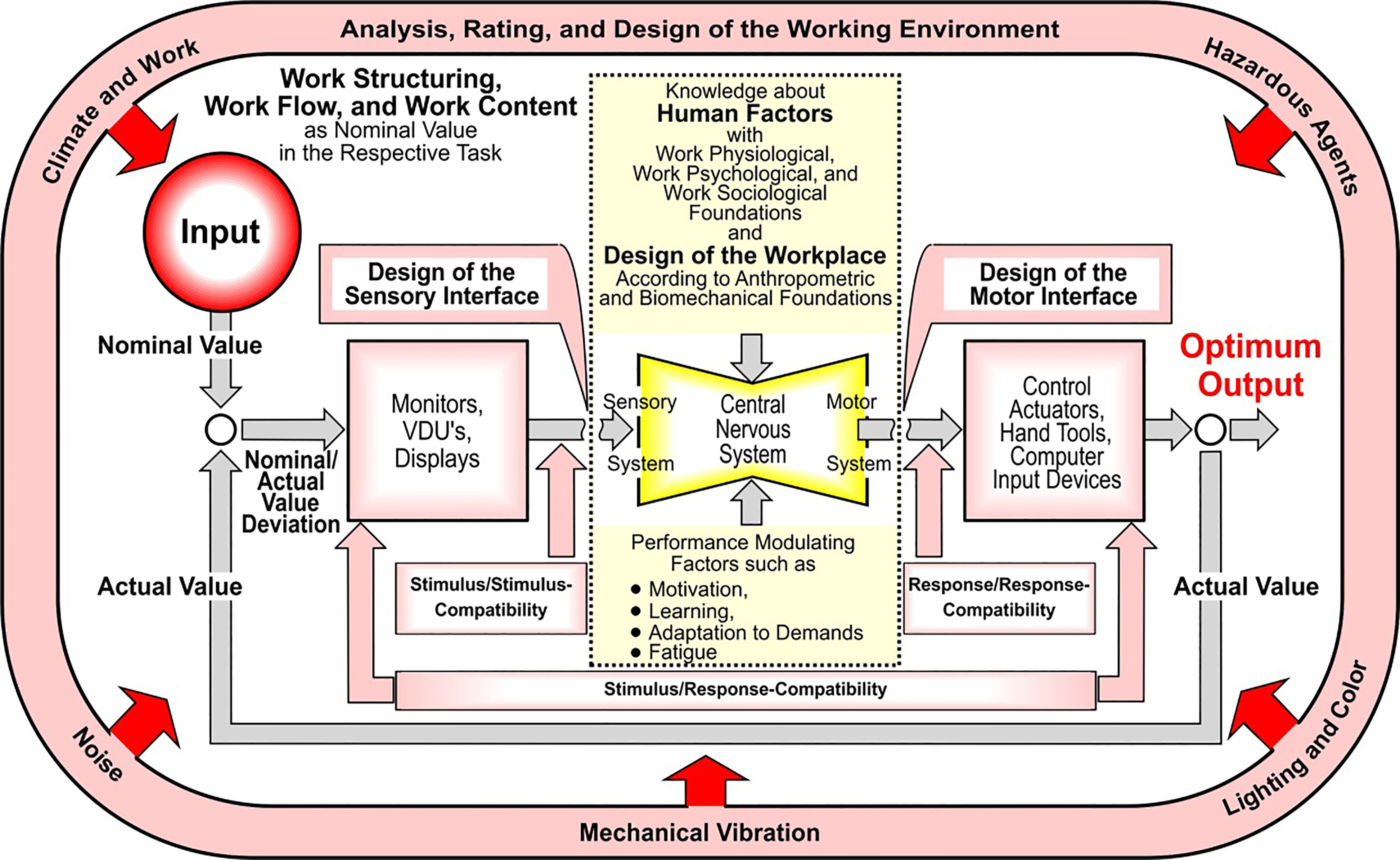
The guiding principle must be compatibility, in particular
• stimulus-stimulus compatibility,
• response-response compatibility, and finally
• stimulus-response compatibility.
Stimulus-response compatibility can be attained by corresponding relations between causes and effects, i.e. an unequivocal arrangement of controls and displays on a panel or an instrument board. For example, it will be expected that the effect of a rotary manual movement on a control will be associated with a cursor displacement on a round scale of a corresponding display. For the purpose of safe and quick operations, a corresponding spatial and functional arrangement normally is the basis for target-oriented actions and reaction possibilities of the human being.
Response-response compatibility, amongst other objectives means, that the equation “suitable for the human body
Stimulus-stimulus-compatibility in the sensory interface often is a prerequisite for minimizing of the physiological expenditure (mainly for the physiological cost) of the eyes and can be achieved when natural appearance and the artificial display suit one another most favorably, when reality and its technical image correspond as much as possible. This important principle of ergonomic work design may be shortly visualized by some practical examples (cp. Figs 2–5).
Normally, data or text of manuscripts is printed in black ink on white paper, and when it has to be typed into a PC, is should follow without questions, that the characters and numbers should be presented on the VDU screen in positive polarity by also black characters on a light screen (cp. left part of Fig. 2). Herewith the adaptation effort during the change from looking at a monitor to viewing the VDU screen can be minimized, while the inverse presentation on a VDU screen with negative polarity (cp. right part of Fig. 2) increases the adaptation effort for the eyes.
Figure 2.
VDU Screen with positive and negative polarity.
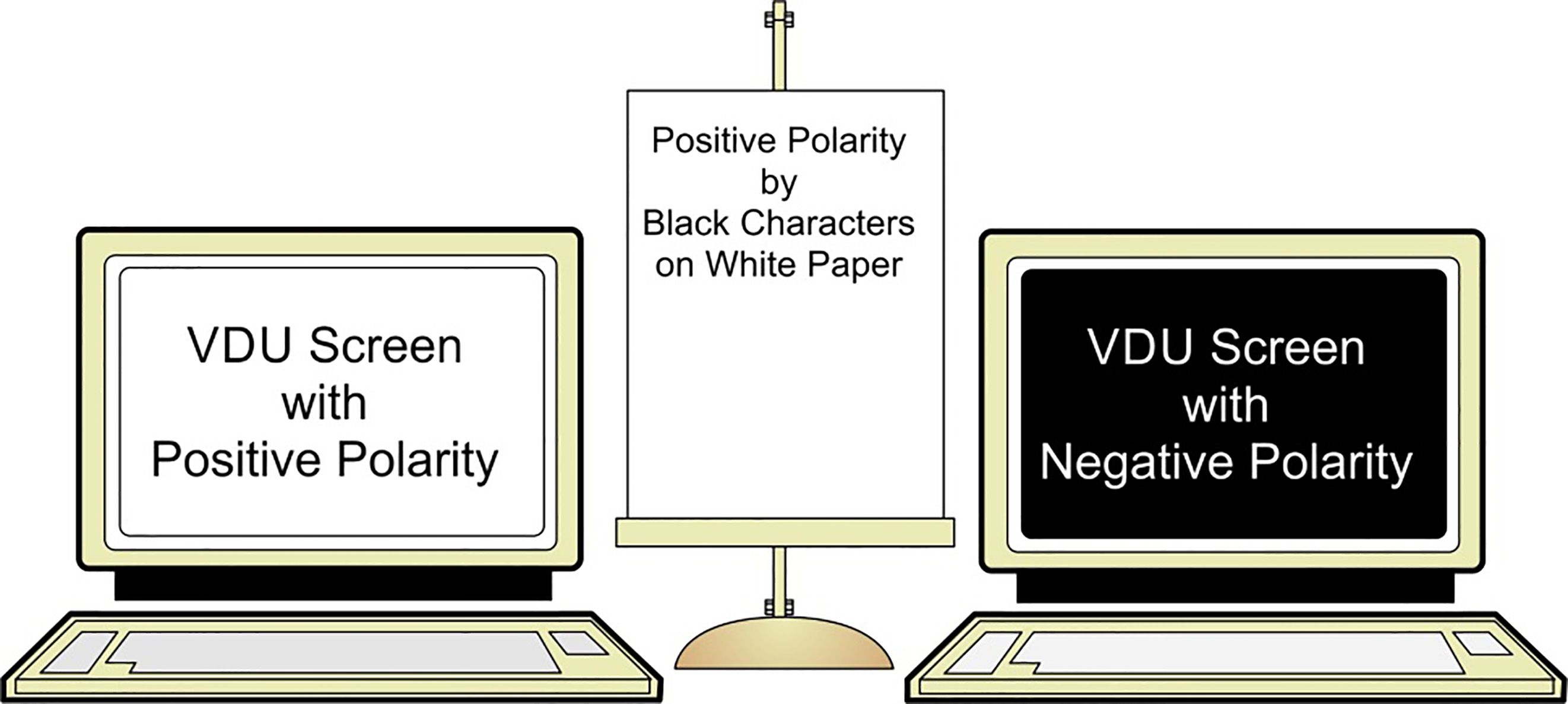
Compatibility of natural and technical display besides decreasing the adaptation requirements for the eyes, creates a higher visual acuity for the same numeric contrast, and also lowers the danger of reflections by mirroring sources. Red characters on a blue colored surface, as printed on a conference flyer shown in Fig. 3, of course, are unfavorable since wavelength-dependent refraction of light in the lens induces “Chromatic Aberration” with scarcely readable characters on a surface in a distinct plane.
Figure 3.
Unfavorable presentation of red characters on a blue-colored surface inducing “Chromatic Aberration” due to wavelength-dependent refraction of light in the lens (cp. [3]).
![Unfavorable presentation of red characters on a blue-colored surface inducing “Chromatic Aberration” due to wavelength-dependent refraction of light in the lens (cp. [3]).](https://ip.ios.semcs.net:443/media/oer/2017/13-S1/oer-13-S1-oer250/oer-13-oer250-g003.jpg)
Compatibility for reducing physiological cost but also for quick and safe information transmission between the technical means, and the sense organ “eye” also demands an orthogonal top view and a suitable viewing distance (cp. left part of Fig. 4) which should not be restricted to just 50 cm (not seldom prescribed in regulations and standards) but should always be larger, especially for users with an advanced age, as will be shown in Chapter 5. A seated work place with a divided height adjustable table should enable an individual adaptation to the manual and visual working height. Of course, also dynamic sitting should be possible, which can be realized by a chair designed according to the synchronous technique (cp. right part of Fig. 4). In such a chair construction compatibility between the anatomical knee and hip joints and the functional joints of the seat pan and backrest is obeyed.
Figure 4.
Divided height-adjustable table for the individual adaptation to manual and visual working height enabling an orthogonal top view and a suitable viewing distance (left part) and compatibility between the anatomical knee and hip joints and the functional joints of the seat pan and backrest in chairs with synchronous technique (right part).
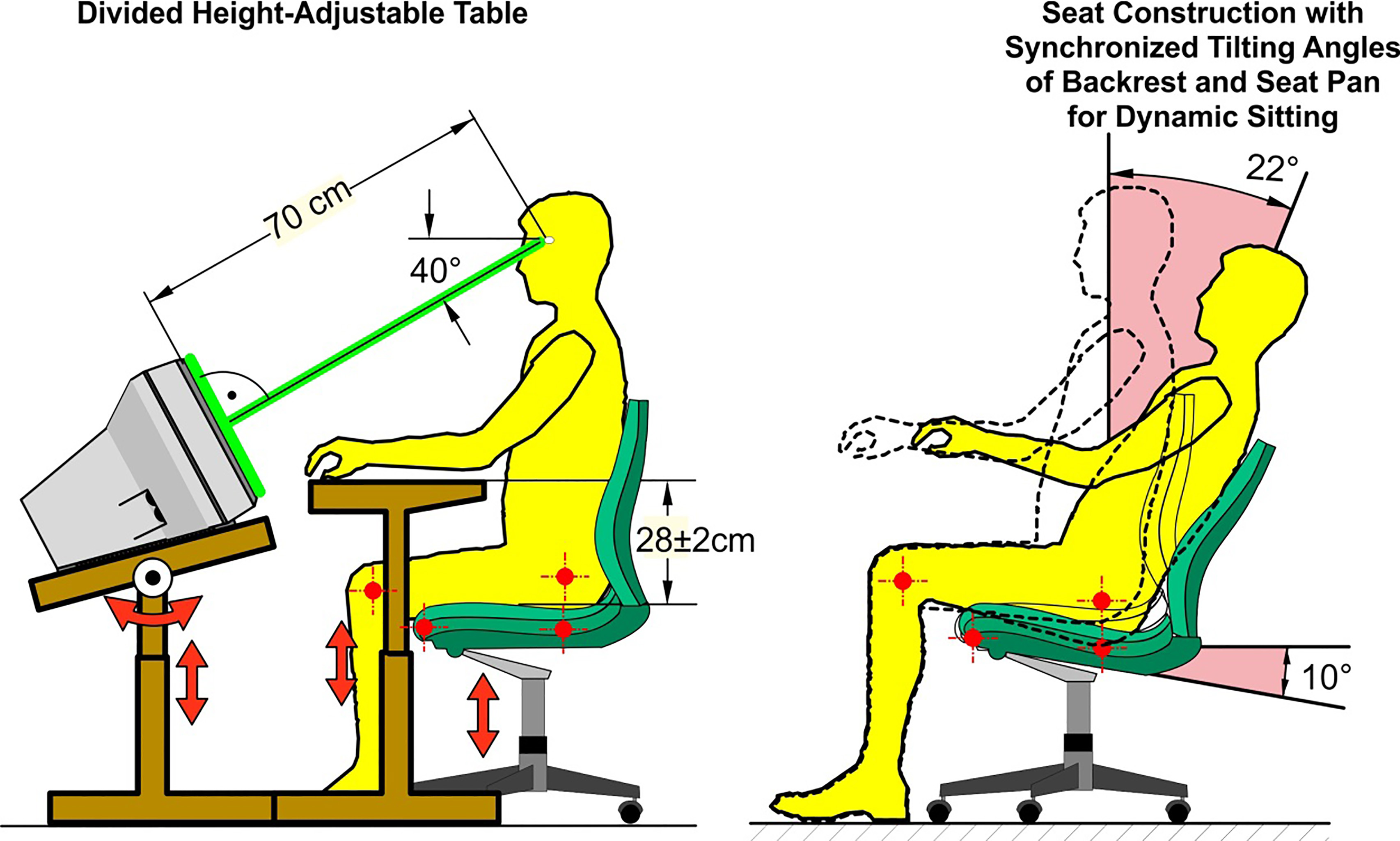
Coming back to the control system “Work”, an additional task of ergonomics consists, of course, in the optimization of the working environment. According to the outer ring of Fig. 1 it must be ensured that “Climate and Work” harmonize, that individuals are protected from detrimental acoustic stress (i.e., noise) and that “mechanical vibrations” or “hazardous agents” are avoided and that “lighting and color in the workplace” are appropriate. But also according to Fig. 5 entire knowledge about the effects of aging on various performance variables must be incorporated into ergonomic work design with respect to the Sensory System, the Motor System, and the Central Nervous System.
Figure 5.
Age-adjusted work design via obeying the effects of aging on the sensory and motor system and on the central nervous system.
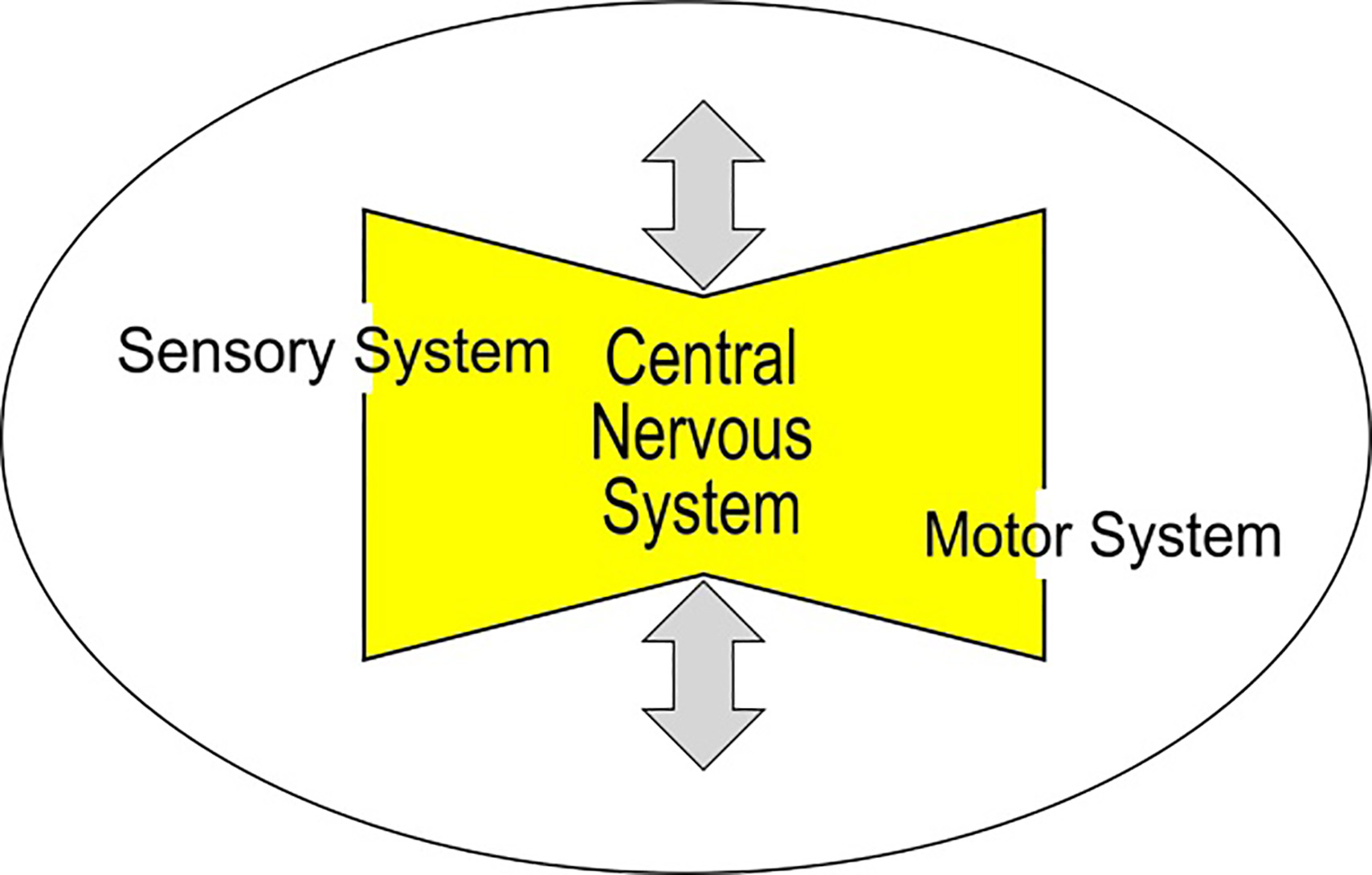
3.Physical age-related changes in performance potential
Beginning with the functions of the physical performance potential and the existing interdependencies as shown in Fig. 6 and as described in [4], “muscle strength” and the “sensorimotor performance potential“ have to be considered. The course of aging of muscle strength in dependence on gender and age that is shown in Fig. 7 probably is well-known. Details see, e.g., [5, 6, 7].
Figure 6.
Outline of physical performance potential.
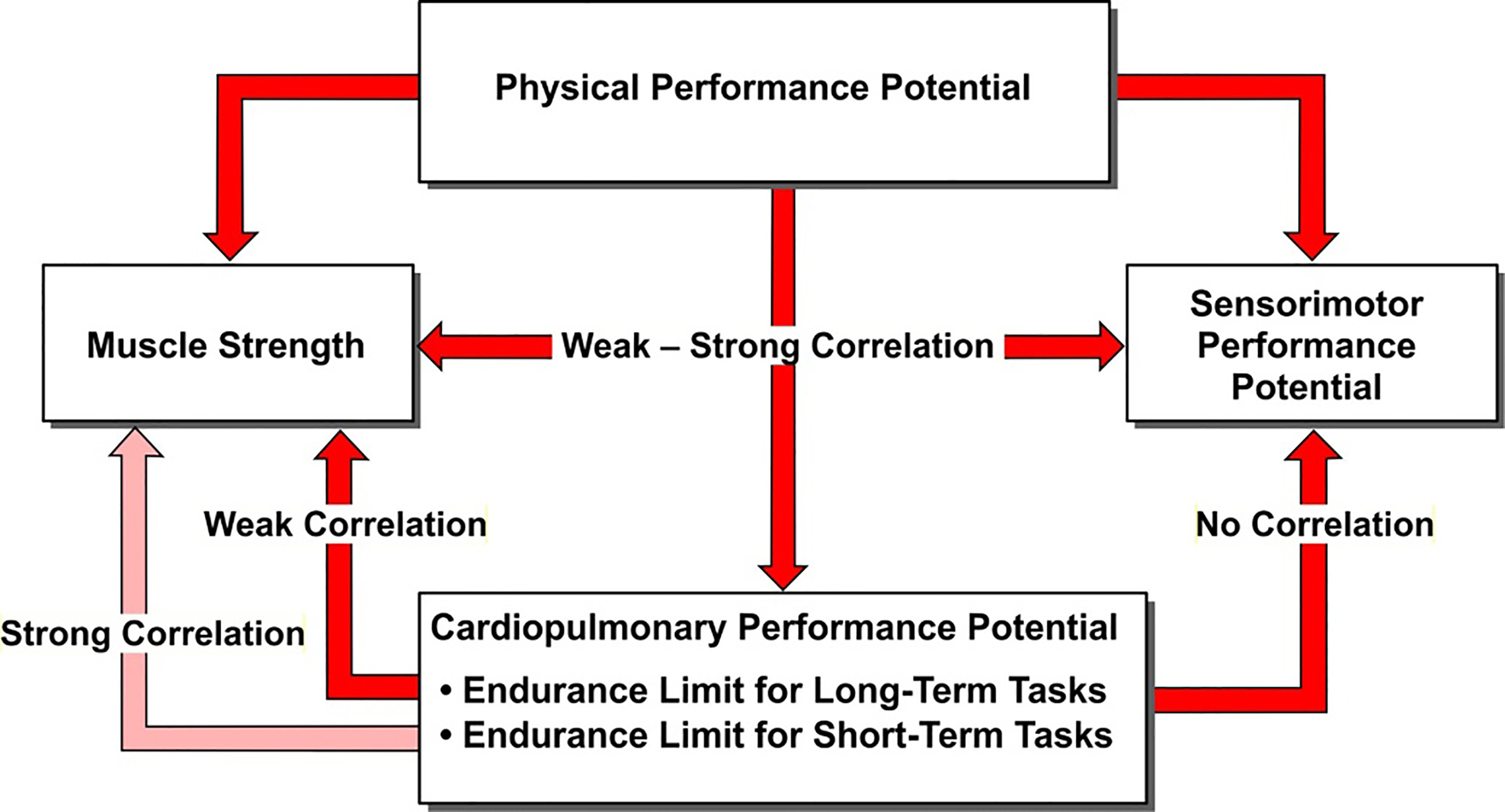
Figure 7.
Muscle strength in dependence on gender and age.
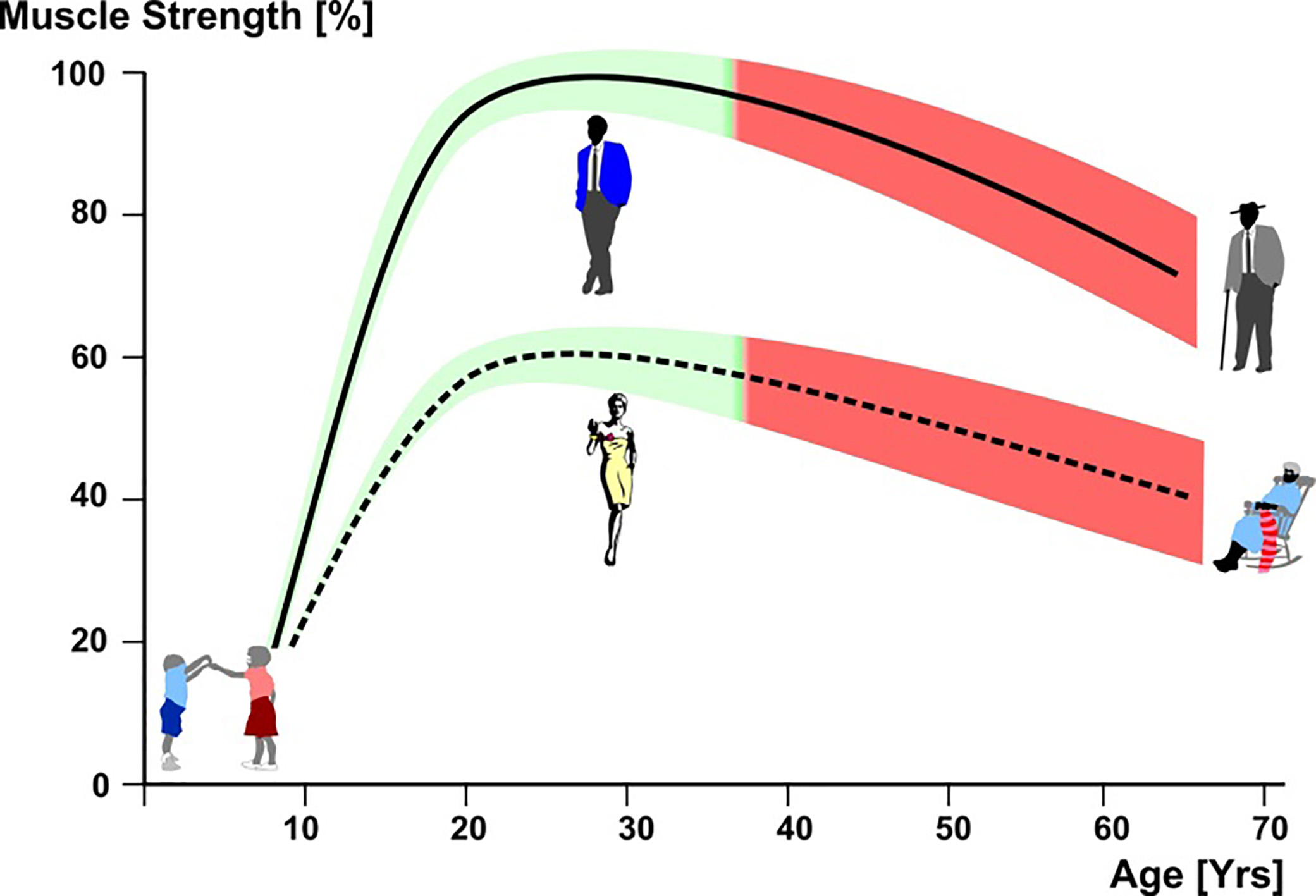
After passing the performance maximum for men and woman in the age of 20 to 30 years, inevitably a continuous decreasing in muscle strength occurs. However, in industry this is less of a concern nowadays with the diminishing role of physical work than in a time when it was the human body’s physical strength that was of the highest importance. Many tasks which involve carrying heavy loads can be taken over by robots. In health care, however, it may be of high relevance still in the future when, e.g., a heavy patient has to be transported from his bed to a wheel chair and vice versa.
Except to health care, to maintain a 20- to 30-year old’s maximum muscle force will, however, seldom be requested over time. It may be mentioned that 50% of the maximum strength can be exerted only over 1 minute. With respect to age-dependent muscle strength it would be foolish, however, to ignore that
• “While physical strength cannot increase beyond a certain mid-day peak of life, there is no such limit for intellectual strength.”
Hilty (1833–1909), a Swiss philosopher and lawyer, author of this sentence, also stated
“This is the true consolation to an aging person.”
By the way, Carl Hilty also believed in “Work as the Source of Health” and it should be mentioned that in the 19
And there is a positive side to the sayings that
• “A rolling stone gathers no moss” and
• “Resting means rusting”
since physical work and exercise, even at an advanced age, keep a body in shape. The range of variation (standard deviation) for, e.g., the course of aging of some physical output functions such as the maximum oxygen uptake as shown in Fig. 8 fortunately is substantial. It may be recognized that old-age athletes, at least to some extent, are able to escape the average curves of a drastic decreasing performance and that gives a reason to hope.
Figure 8.
Maximum oxygen uptake of men and women in dependence on age. Means from 2334 subjects, according to Hollmann. Source [8].
![Maximum oxygen uptake of men and women in dependence on age. Means from 2334 subjects, according to Hollmann. Source [8].](https://ip.ios.semcs.net:443/media/oer/2017/13-S1/oer-13-S1-oer250/oer-13-oer250-g008.jpg)
4.Sensory-motor course of aging
With respect to motor function and swiftness (Fig. 9) the picture, of course, is less rosy. The required time for gripping and transposing an item is substantially longer for 60-year olds than for men and women around the age of 30.
Figure 9.
Performance of the right hand during gripping and transposing items in dependence on age and gender [9], also cited in [8].
![Performance of the right hand during gripping and transposing items in dependence on age and gender [9], also cited in [8].](https://ip.ios.semcs.net:443/media/oer/2017/13-S1/oer-13-S1-oer250/oer-13-oer250-g009.jpg)
According to Fig. 10, the same is true for the number of assembled units per time. Already 40-year olds and especially 50-year olds cannot keep pace with 30-year olds. Appropriately repetitive tasks, however, should nowadays be left to robots and operation systems.
Aging becomes a truly serious issue when it comes to vision and hearing, the two most important sense organs.
5.Course of aging of the vision
According to well-known early and fundamental research in physiology (e.g., shown in [10]) which is also found in ergonomics textbooks or encyclopedias (e.g., [11, 12, 13, 14, 15]), a dramatic decrease in accommodation of the eye lens is associated with aging. Figure 11 exhibits that twenty-year olds have an average accommodation of more than 10 diopters, i.e. that they are capable of adjusting their eye lens such that an object that is at a distance of approximately 0.1 m from the eye can be focused onto the retina.
Figure 11.
Decrease in accommodation of the eye lens (in diopters) and increase in (minimum feasible) distance at which the eye can still focus (in meters) in dependence on age. Source [16].
![Decrease in accommodation of the eye lens (in diopters) and increase in (minimum feasible) distance at which the eye can still focus (in meters) in dependence on age. Source [16].](https://ip.ios.semcs.net:443/media/oer/2017/13-S1/oer-13-S1-oer250/oer-13-oer250-g011.jpg)
Figure 12.
Approximation curves for accommodation time of 40- and 30-year olds during vision adjustment from far-away to close-by objects.
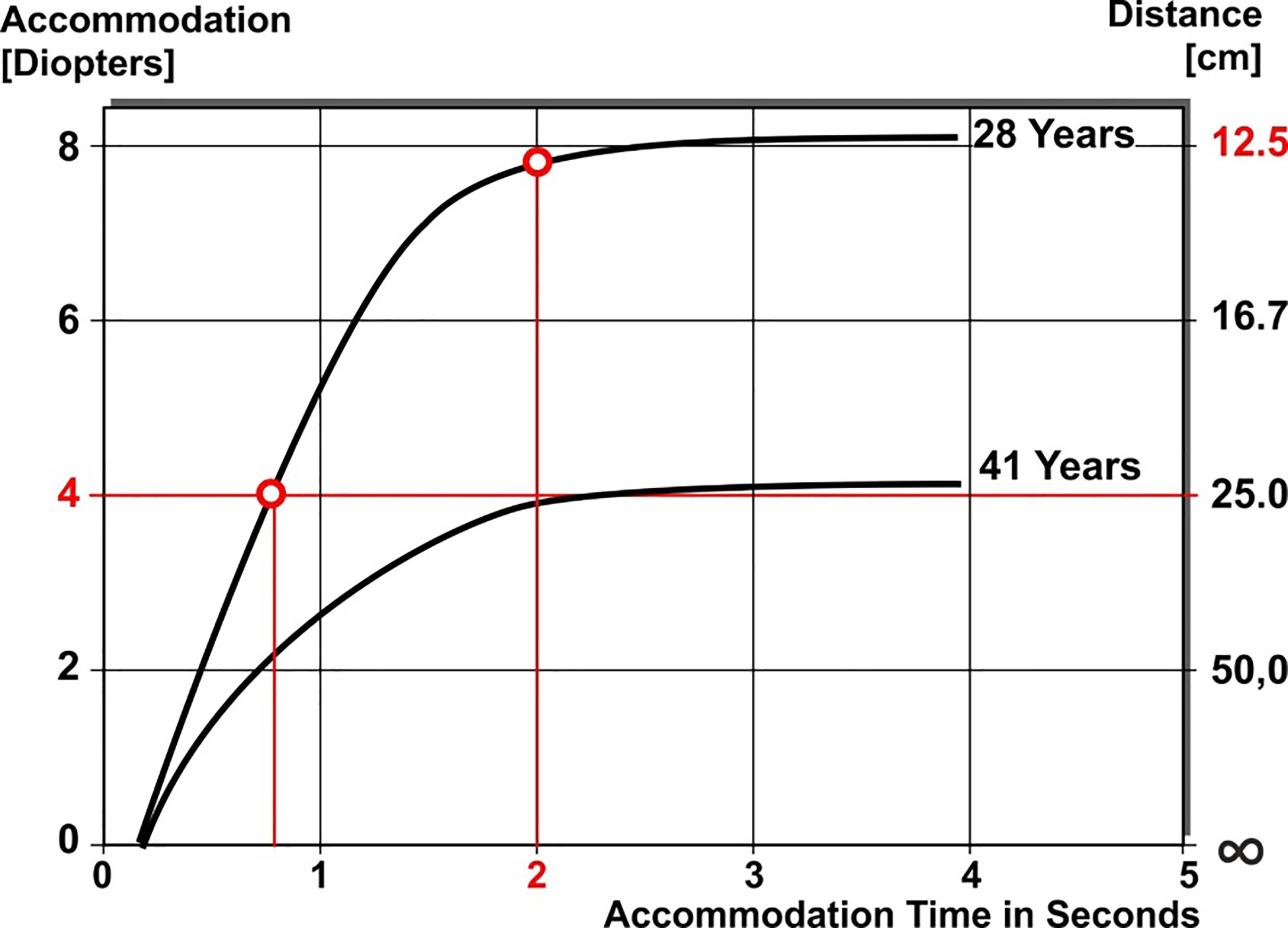
Figure 13.
Course of aging of the visual acuity.

Figure 14.
Impact of adaptation luminance (left) and contrast (right) on the visual acuity of different age groups. Sources [16, 17].
![Impact of adaptation luminance (left) and contrast (right) on the visual acuity of different age groups. Sources [16, 17].](https://ip.ios.semcs.net:443/media/oer/2017/13-S1/oer-13-S1-oer250/oer-13-oer250-g014.jpg)
This minimum feasible distance at which the eye can still focus already increases to 0.25 m for 40-year olds because the refraction power has decreased from 10 to 4 diopters, i.e., less than half the initial value. Fifty-year olds, having experienced a further decrease to 2 diopters are at the limit of their maximum accommodation when they work at a distance of 0.5 m to a computer monitor and 60-year olds, with an average value of 1 diopter, are only able to focus on items that are at a distance of at least 1 m from the eye unless they use a type of vision aid. This explains the origins of the saying that
• “The eyes still work fine, but the arms are too short”
when the arms are stretched out while reading a newspaper. While vision aids may compensate for a lack in refraction power, the speed of accommodation, i.e., how quickly the lens can focus on an item that is close by, is also to a good extent dependent on age. This is shown in Fig. 12 for two groups with an average age of 28 and 41 years.
Even around 40-year olds – and they should not be regarded as old people – require substantially more time than around 30-year olds to adjust their vision from far-away to close-by objects. For example, a 4-diopter adjustment, i.e. an accommodation to a distance of 25 cm from the eyes, which is the limit (feasible minimum) for 40-year olds, takes almost 2 s while around 30 year-olds can manage that within less than 1 s. Thirty-year olds, furthermore, are able of accommodation at 12.5 cm, i.e., at half the distance, within the same amount of time (2 s). The varying accommodation time which cannot be compensated by any glasses or technical aids may be experienced via looking at a TV screen in a distance of some meters and after that having a short look into the TV program in a distance of approximately 50 cm. According to Fig. 13, for a 60-year old, the visual acuity as a measure for the eyes’ spatial resolution is still high with approximately 75% of a 20-year old’s acuity.
However, such limitations are still cause for concern if the demands in the workplace are high. As shown in the left part of Fig. 14, a visual acuity of 100% (i.e. 1.0), can be attained by 20-year olds even with dim lighting or a marginal luminance of 10
Ensuring a visual acuity of 1.0 for 50- or even 60-year olds, which is essential for many industrial inspection tasks, would require a substantial investment in terms of lighting. In order to achieve a visual acuity of 100% (V
Figure 15.
Luminance and contrast requirements with the goal of ensuring that different age groups achieve a certain visual acuity (which is required, e.g., for inspection tasks). Source [17].
![Luminance and contrast requirements with the goal of ensuring that different age groups achieve a certain visual acuity (which is required, e.g., for inspection tasks). Source [17].](https://ip.ios.semcs.net:443/media/oer/2017/13-S1/oer-13-S1-oer250/oer-13-oer250-g015.jpg)
In summary, Fig. 16 drastically shows how vision gets worse with increasing age unless an investment in additional lighting is provided. Assuming an average age of 40 for the working population, a 50-year old requires double and a 60-year old five times the amount of light in order to achieve the same visual performance. Relative to a 20-year old who only requires half as much light as a 40-year old, there is a difference of a factor of ten in the need for light between 20- and 60-year olds to provide age-adequate lighting. Thus, the range is on the same magnitude as for the accommodation.
Figure 16.
Age and lighting needs as multiples of a 40-year old’s needs for constant visual performance (according to Dall). Source [16].
![Age and lighting needs as multiples of a 40-year old’s needs for constant visual performance (according to Dall). Source [16].](https://ip.ios.semcs.net:443/media/oer/2017/13-S1/oer-13-S1-oer250/oer-13-oer250-g016.jpg)
6.Course of aging of the hearing
Not only the eye as the most important sense organ, which with its channel capacity of 80–90% plays the crucial intermediary role with the environment, is affected by drastic age-related performance losses. Unfortunately, also substantial age-related performance decreases in the hearing must be expected. As shown in Fig. 17, especially the acoustics in the upper frequency range are adversely affected.
A 20-year olds hearing experiences a wonderfully broad acoustic world of frequencies of approximately 10 octaves that are in the audible range from 16 Hz to 16,000 Hz. With every decade, approximately 2 kHz are lost at the upper end of the hearing range, i.e., at the age of 30, the maximum value is 14 kHz. At 40, this value has declined to 12 kHz and at 50, frequencies up to 10 kHz represent the limit that is detectable by the hearing. And once the age of 60 has been reached, the purchase of an expensive stereo equipment with a “valuable” bandwidth of 20 kHz does not make sense because of a hearing range with an upper limit of 8 kHz. Such a purchase only benefits the seller, but not the aged consumer. The age-related hearing loss as an elevation of the hearing threshold can be measured via audiometry at different frequencies [15]. Table 1 contains measurements of the age-related hearing loss in Deci-Bels (dB) between 1 and 6 kHz for men and women in steps of 5 years.
Table 1
Age-related hearing loss (dB). Source [18]
| Men | Women | |||||||||
| Age [Years] | Test Frequency [kHz] | Test Frequency [kHz] | ||||||||
| 1 | 2 | 3 | 4 | 6 | 1 | 2 | 3 | 4 | 6 | |
| 0 | 0 | 0 | 0 | 0 | 0 | 0 | 0 | 0 | 0 | |
| 25–30 | 0 | 0 | 1 | 1 | 2 | 0 | 0 | 1 | 1 | 1 |
| 30–35 | 0 | 1 | 3 | 4 | 5 | 0 | 1 | 2 | 2 | 3 |
| 35–40 | 1 | 3 | 5 | 7 | 9 | 1 | 2 | 3 | 4 | 6 |
| 40–45 | 2 | 5 | 8 | 11 | 14 | 3 | 4 | 5 | 7 | 9 |
| 45–50 | 4 | 7 | 12 | 16 | 18 | 4 | 6 | 8 | 10 | 13 |
| 50–55 | 5 | 9 | 17 | 20 | 24 | 6 | 8 | 11 | 13 | 18 |
| 55–60 | 7 | 12 | 21 | 26 | 30 | 7 | 11 | 14 | 17 | 22 |
| 60–65 | 9 | 16 | 26 | 31 | 37 | 10 | 14 | 18 | 22 | 28 |
Young men up to the age of 25 typically do not experience any limitations of their hearing and the following years usually pass without any substantial losses, as measured in dB. As the years go by, however, substantial hearing losses are almost impossible to avoid. Approximate hearing losses from 10 to 30 dB and more mean that people above the age of 60 experience an acoustic world that is considerably attenuated. By the way, what is just established for men and their age-related hearing losses is slightly different for women (cp. right part of Table 1). Women seem to be the stronger sex as they age. Their age-related hearing losses are less severe by approximately 5 to 10 dB. As previously mentioned, presbyacusia is characterized by limitations of the hearing, especially at higher frequencies. In this context it should be known, a reduction of 10 dB already corresponds approximately with a halving of the subjectively experienced loudness, and a reduction of 20 dB already decreases the dynamics of sound to 1/4. A reduction of 30 dB means a further decrease to 1/8. For getting an impression what a reduction of 20 or 30 dB means, the effect of closing a window or a door may be regarded. Traffic noise or noise from floors caused by talking or walking people can be reduced substantially by blocking these noise sources by closing windows and doors. Considering that normal communication takes place at levels around 60 dB, it becomes clear that an elderly individual whose hearing has diminished by 20 to 30 dB is rather isolated from his acoustic surroundings. As is well known, increasing the volume by the missing “dB” is a double-edged sword. Increasing the volume of amplification by a hearing aid means a correspondingly increased stress and possible overload for the still active hair cells in the inner ear, and in the long run they also may be damaged. The above reported data represent average values, and everybody can hope, of course, that he personally, statistically speaking, is in the lower end of the range of variation and thus in a better position. Should one be among the “losers,” and there must be some, he may find comfort in the following bit of wisdom by Bernhard Shaw (1856–1950), an Irish play writer and receiver of the literature Noble prize:
• “There are two great advantages to old age: One’s teeth no longer hurt, and one no longer hears all the nonsense that people say.”
The right part of Fig. 18 once again shows the not exactly pleasant results of large-scale epidemiological studies of men who were not exposed to any explicit noise during their lifetime. These somewhat dated, yet still representative, data show that drastic losses on the magnitude of 20 to 50 dB and more can be expected between 2 and 6 kHz when the population in the western world and the northern hemisphere is in the range of 40 to 60 of age. Interestingly, the age-related hearing threshold shifts of the Mabaan (cp. left part of Fig. 18) are less severe. The hearing of the hunters and gatherers of this tribe of the African outback who had neither drums nor firearms, even that of 70- to 80-year olds, exhibits only few limitations and can almost be described as excellent. Typically, this is no longer the case for the population in the western world once they reach the age of 30. Presumably, this is due not only to the typical high-tech environment at work, but also because our everyday life is much too noisy and we must acknowledge that presbyacusia in our modern world is a type of disease of civilization.
Figure 18.
Range of audibility (for males) in several decades of life.
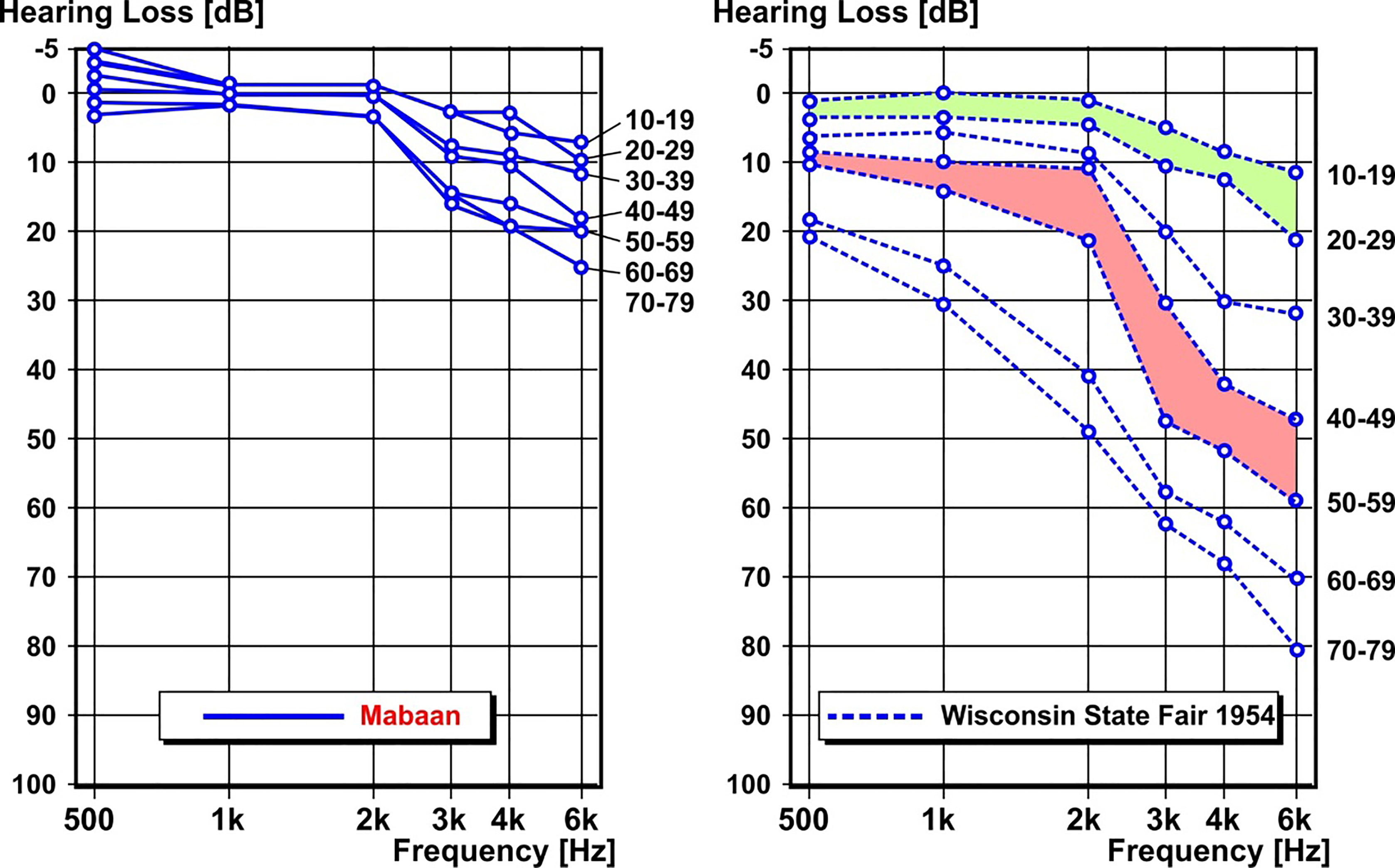
7.Central nervous and cognitive age-related changes
As far as age-related changes in the central nervous system and in mental-cognitive performance areas are concerned the information that has been presented on hearing and vision leaves no doubt that a certain
• “Fading of sensations” occurs. This is confirmed by the saying that
• “All senses get weaker in old age, but the stubbornness thrives.” Hence, the
• “Limitation of the mental capacity to the well-known”
has to be added to the list in the upper part of Table 2. The
• “Slowing down of psychomotor processes” has already been mentioned in a preceding chapter.
Table 2
Age-related changes in the central nervous system and in mental performance as well as “demanding” requirements for “older” employees. [8]
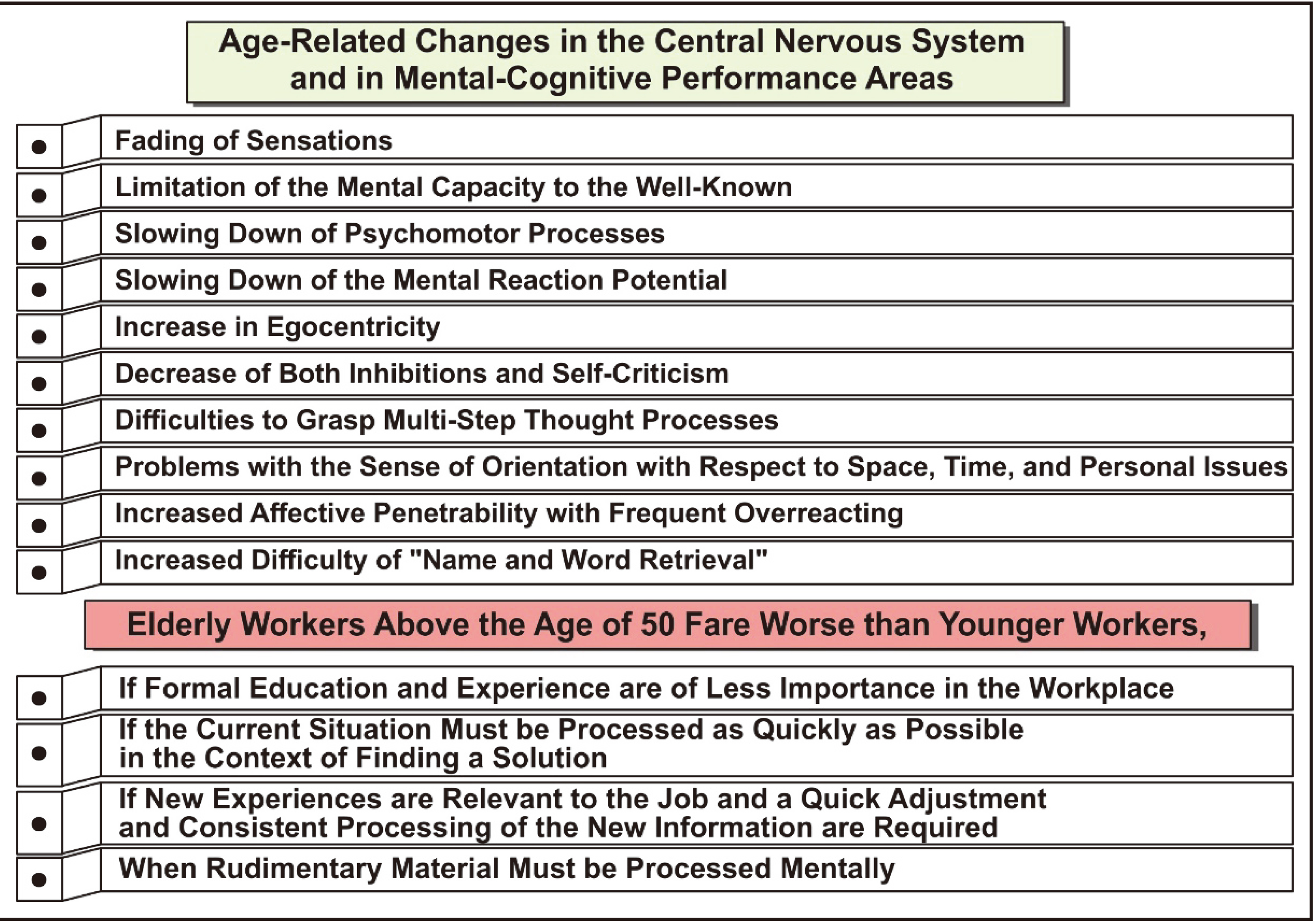
|
According to an aphorism, however,
• “A person’s true age (in biological rather than in calendrical terms), can allegedly be seen by observing whether he takes two steps or two pills at a time.”
To continue the list of the deficit hypothesis, a
• “Slowing down of the mental reaction potential” and an
• “Increase in egocentricity” can also be expected. This can possibly also be applied to the
• “Decrease of both inhibitions and self-criticism” which allegedly occurs with age.
• “The difficulties to grasp multi-step thought processes” and the
• “Problems with the sense of orientation with respect to space, time, and personal issues”
as well as wavering and hesitating may have contributed to the following wisdom
• “Old age measures and weighs. Youth wants no delays”
that was already quoted by Plato (427–347 B C), one of the most important ancient Greek philosophers. This wise old man reaching the age of 80 was famous for a lot of favorite sayings, e.g.
• “Love is a serious mental disease” or also more positive and motivating
• “At the touch of love everyone becomes a poet” or again with respect to aging
• “Never discourage anyone who continuously makes progress, no matter how slow.”
Two final hypotheses of alleged
• “Increased affective penetrability with frequent overreacting” and the hardly disputed
• “Increased difficulty of name and word retrieval” conclude the list of the deficit theory.
More than 30 years ago, Müller-Limmroth drew the following – possibly slightly exaggerated – conclusions with respect to work potential when he stated (cp. lower part of Table 2)
“Elderly workers above the age of 50 fare worse than younger workers”
• “If formal education and experience are of less importance in the workplace,”
• “If the current situation must be processed as quickly as possible in the context of finding a solution,”
• “If new experiences are relevant to the job and a quick adjustment and consistent processing of new information are required,” and
• “When rudimentary material must be processed mentally.”
8.Outlook
8.1Positive issues of aging on working performance and additional wisdoms on age
Despite all the listed “changes in behavior” that not necessarily do occur but become more likely in old age, it would be inappropriate to equate aging with throwing someone to the “scrap heap” when
“Experience,” “Prudence,” and “Strategic and cross-linked thinking”
are needed in the workplace. According to [19] qualities that even tend to improve with age are the
• “Ability to plan ahead,”
• “Sense of responsibility,”
• “Reasoning powers,” i.e. the ability to draw inferences or conclusions through the use of reason.
• “Independence” as well as
• “Diligence in the workplace” are also qualities that can increase with age.
A popular meanwhile aged politician, former member of the German government and responsible for the department “Work and Health” who was not always correct in his decisions when he was young, was probably right when he stated:
• “Pushing out older workers would mean that a society would ignore experience, remembrance, and history” and
• “Even a grandmother’s advice possibly contains more wisdom than the science of a twenty-year old expert in social matters.”
With regard to the latter, nowadays one may question the “wisdom“ of a young computer scientist who is too fixated on the digital world. A few more optimistic aphorisms may conclude the outlook:
• “There is no way to avoid getting old, but it is possible to fight getting antiquated.”
Also Goethe’s rich experiences go well with the topic “The Art of Aging” when he found out
• “It is not hard to become old, but bearing it is.”
Johann Wolfgang von Goethe (1749–1832) who had tight and friendly relations to the dramatist and philosopher Friedrich Schiller – the latter did not possess outstanding competency in aging, since he died already in the age of 45 – may be known world-wide like Shakespeare. He was a genius poet and probably known for his most celebrated drama “Faust” or “Wilhelm Meister’s Apprenticeship”.
He was, however, not only credited with excellent spirit and universal knowledge. But also with an astonishing practical competency, when surprisingly, like a factory manager, a work scientist or an ergonomist today, then, 200 years ago, he was involved in inquisitive job analysis and supervising mining plants or in glass and pottery manufacturing facilities. Although his literacy work had attracted the greatest amount of interest, Goethe was also keenly involved in studies of natural science. Searching studies and close observations on the effect of diametrically opposed colors led him to a symmetric arrangement of his “color wheel” which in 1810 was published as “Theory of Colors”, considered by himself as his most important scientific work. Remarkably, in the year 1857, just around 50 years after Goethe‘s physiologically-based studies, Wojcech Bogumil Jastrzebowski created in Poland the foundations of Ergonomics with the treatment “An Outline of Ergonomics, or the Science of Work based upon the truth drawn from the Science of Nature”.
Goethe‘s serious physiological studies seem to have been guided by the motto “Who does not love wine, women and song, remains a fool his whole life long”, since he describes his experiences with the local adaptation of the rods and cones in the retina (leading to opposed color impressions) in a story dealing with focusing a lovely young lady in a wine cellar (see color pictures and text in Fig. 19).
Figure 19.
Local adaptation of rods and cones in the retina after focusing the eyes on a young lady.

From Goethe‘s rich experiences concerning aging we also can learn that
• “It is never too early to find out how expendable one is in this world.”
Hence, already elderly people should be guided by the following metaphors
• “Aging is like an ocean wave. Let the wave take over, and you will float on top. Try to fight it, and you will drown”, and
• “You’re old if the past gives you more pleasure than the future.”
The last aphorism, which stems from John Knittel (1891–1970), a Swiss writer, who published all his novels, stories as well as wisdoms in English should make us a little meditative. But Gotthold Ephraim Lessing (1729–1781), a philosopher and poet of the 18
• “What delight, if it is said: Old man, you may be rich in years, but your intellect is flourishing.”
“Fitting the Task to the Man” [20] is the title of a famous ergonomic text book. The title of this book is a mission and responsibility for ergonomists and, of course, means, that human-computer-interaction and all the working conditions have to be designed in harmony with physiological and psychological characteristics of the operator. But does it mean to regard only a standardized or normalized human being in the age between 20 and 30? It means, of course, always to think also about age-related performance changes.
8.2Approaches of age-differentiated work design
“Age-differentiated work design”, fortunately, nowadays again is an important world-wide research topic. So, since several decades, besides Gerontology [21], ergonomics research also included “Aging, Work and Health”. Amongst others, “Work and Aging: A European Perspective” (Eds.: Snel and Cremer) [22] or “The Paths to Produce Productive Aging” (Ed.: Kumashiro) [23] may be mentioned. The proceedings of the XIV
• “The ‘strengths’ of the various stages of life should be purposefully utilized.”
Thus, also in the work environment one should obey the following advice:

Finally, the verses of a lyric poet of the early 13
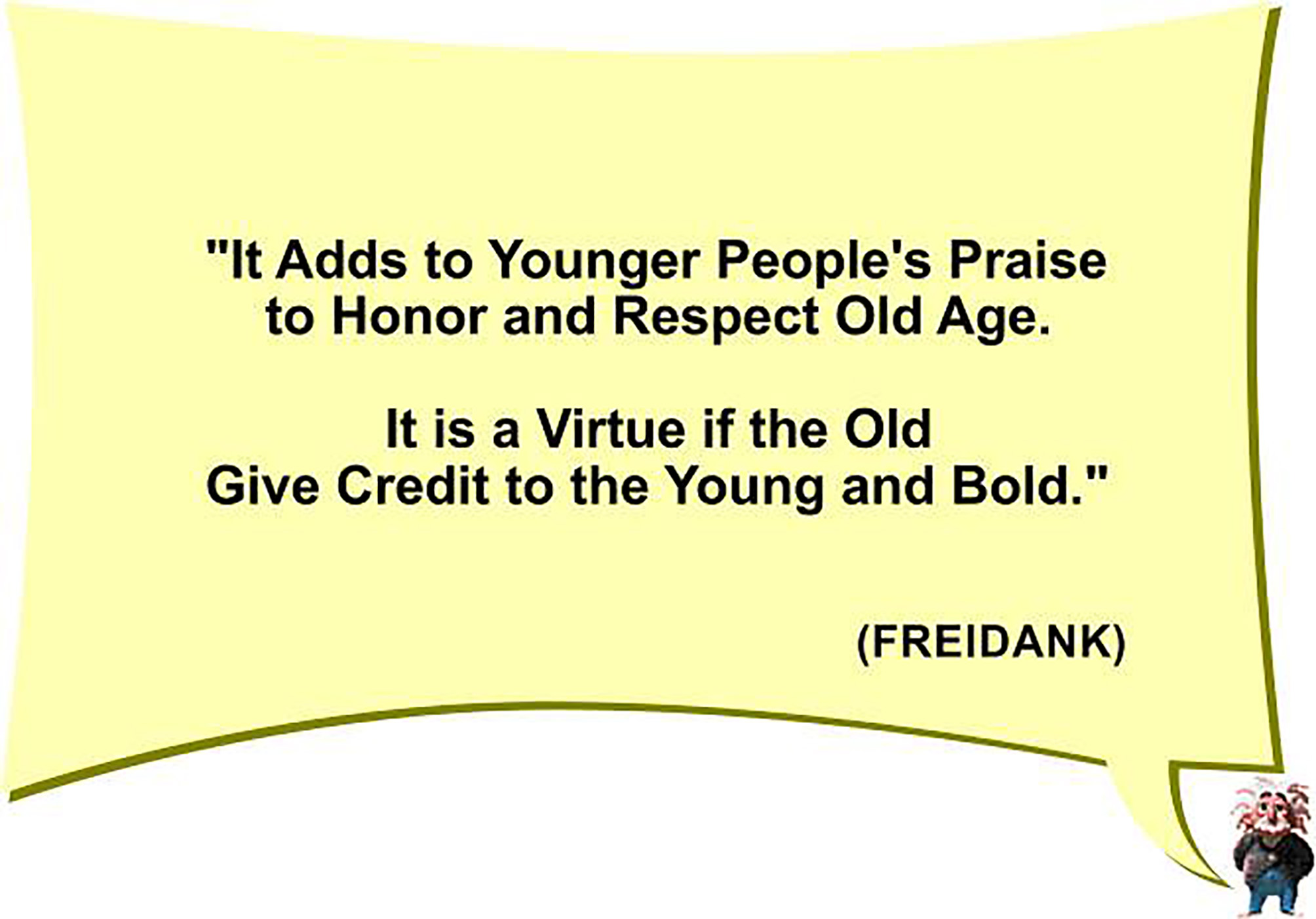
8.3Story about “Length and Quality of Life”
During the reported survey of the course of aging on various human performance potentials from an ergonomics point of view not always pleasant facts have emerged. In order to encourage us to say “Yes” to the course of the working life and to help us accept that some things will be different at an advanced age than we personally would like them to be, these ergonomically relevant facts had been garnished with a lot of “aphorisms” and “wisdoms on age” The following aphorisms from Marcus Tullius Cicero (106–43 B.C.), a Roman politician, a lawyer and philosopher dealing especially with the length of life may round up the wisdom quotes on the “Art of Aging”:
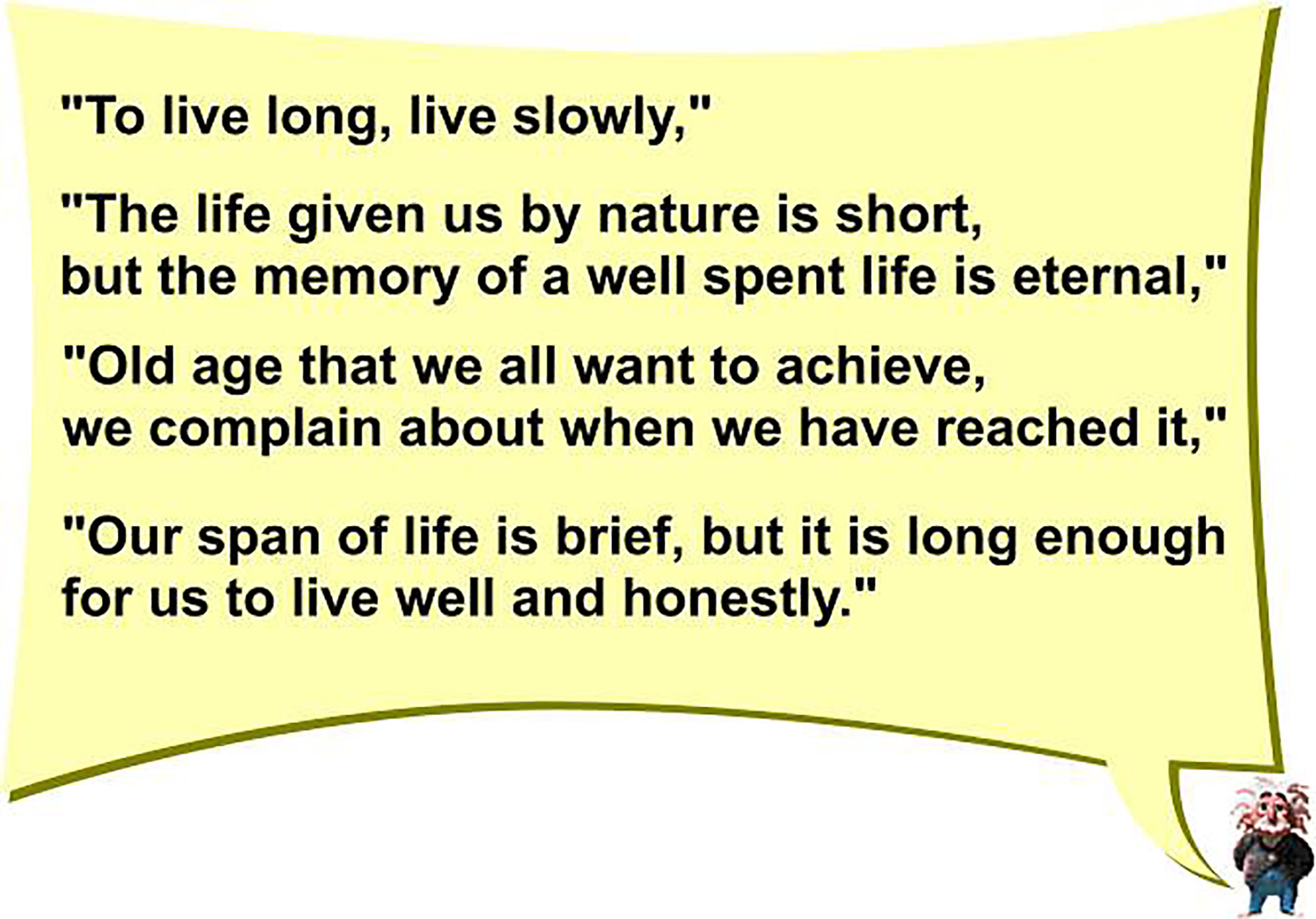
or, indeed, the important statement:

Cicero, however, is also the author of an extraordinary and fascinating story which not only deals with the length but also with the quality of human life. Therefore, finally, Cicero‘s more than 2 000 years old story on “Length and Quality of Life” presented in Fig. 20 (Parts I and II) shall conclude this paper on the art of aging. It tells about an interesting discussion between God and the Donkey, the Dog and the Monkey (Fig. 20 Part I) as well as a discussion and a contract between the Lord and the finally not yet satisfied Man (Fig. 20 Part II). The story may be quite amusing but to some extent it will also make the reader a little bit meditative.
Figure 20.
Length and quality of life (Part I).

Figure 20.
continued (Part II).

It should be a consolation that the discussion listed in Fig. 20 is an anecdote, a fictitious story that illustrates a difficult philosophic topic but not the whole truth. On the one hand, it depends on ourselves how we lead our life. And in the Bible, especially in Verse 10 of Psalm 90, in the Treasure of David we can read that:
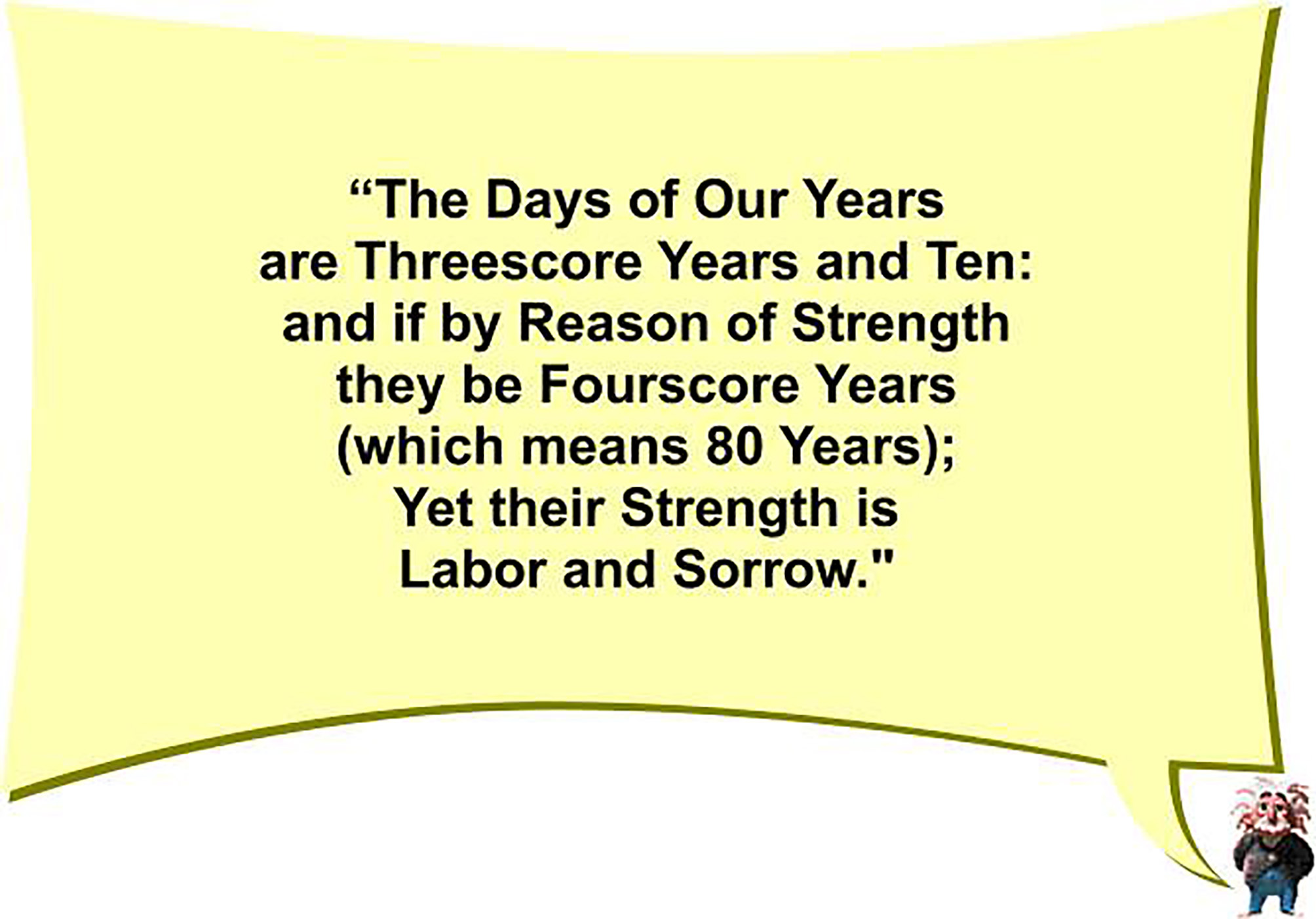
On the other hand, today – more than 2 000 years later – our life often lasts much longer than the granted life by God and the Bible.
9.Conclusions
The survey on age-related changes from an ergonomics point of view was focused on knowledge on physical and sensory-motor performance, the course of aging on the vision and the hearing and on central nervous as well as cognitive age-related changes.
When considering “muscle strength”, after passing the performance maximum for men and women in the age of 20 to 30 years, inevitably a continuous decrease will be experienced. With respect to motor function and swiftness, it has to be stated that the required time for, e.g., gripping and transposing an item is substantially longer for 60-year olds than for men and women around the age of 30. Similar is true for the number of assembled units per time unit. Already 40-year olds and especially 50-year olds cannot keep pace with 30-year olds.
Aging becomes a truly serious issue when it comes to vision and hearing, the two most important sense organs. For example, while 20-year olds exhibit an average accommodation of more than 10 diopters, i.e., they are capable of adjusting their eye lens such that an object that is at a distance of approximately 0.1 m from the eye can be focused onto the retina, 50-year olds, having experienced a decrease to 2 diopters, are at the limit of their maximum accommodation when they work at a distance of 0.5 m to a computer monitor. And 60-year olds, with an average value of 1 diopter, are only able to focus on items that are at a distance of at least 1 m from the eyes unless they use a type of vision aid. In a 60-year old, the visual acuity as a measure for the eyes‘ spatial resolution is still high with approximately 75% of a 20-year olds acuity. However, such limitations are still cause for concern if the demands in the workplace are high. If for instance in industrial inspection tasks a visual acuity of 100% is required, 60-year olds need a 1,000 times higher luminance than 20-year olds. How the vision gets worse with increasing age may be shown by the necessary investment in additional lighting. Assuming an average age of 40 for the working population, a 50-year old requires double and a 60-year old five times the amount of light in order to achieve the same visual performance.
Not only the eye, as our most important sense organ, which plays the crucial intermediary role with the environment, is affected by drastic age-related performance losses. Unfortunately, also substantial age-related changes in the hearing must be expected.
A 20-year olds hearing experiences a wonderfully broad acoustic world of frequencies of approximately 10 octaves that are in the audible range between 16 Hz and 16 kHz. However, with every decade, approximately 2 kHz are lost at the upper end of the hearing range. When looking at the range of audibility in several decades of life, it has to be put in words that for the third decade, i.e. up to the 30-year olds, the hearing loss which can be measured as permanent hearing threshold shifts above the resting threshold remains in a very limited range of up to just 20 dB in the upper frequencies. However, drastic losses of 50 dB and more must be expected between 2 and 6 kHz when the population in the western world and in the northern hemisphere is in the range of 40 to 60 of age.
The negative impact of age on central nervous and cognitive functions is somewhat less severe and there exist some exceptions. Elderly workers above the age of 50 fare worse than younger workers, if formal education and experience are of less importance in the workplace, if the current situation must be processed as quickly as possible in the context of finding a solution, if new experiences are relevant to the job, if a quick adjustment and consistent processing of the new information are required, and when rudimentary material must be processed mentally. Despite all these changes in behavior that not necessarily do occur but become more likely in an advanced age, it would be absolutely inappropriate to equate aging with throwing someone to the “scrap heap” when experience, prudence, and when strategic and cross-linked thinking are needed in the workplace. Qualities that even tend to improve with age are the ability to plan ahead, the sense of responsibility and reasoning power, i.e. the ability to draw inferences or conclusions though the use of reason. Furthermore, independence as well as diligence in the workplace are qualities that can increase with age.
Today substantial changes in the working conditions occur very quickly, therefore, also in the future ergonomics research has to be focused on topics such as “Aging, Work and Health” or “Workability of the Elderly Population”. Hereby, the hypothesis that the “Strengths” of the various stages of life should be purposefully utilized in the work environment has to be proven. Probably, we can follow the advice “When the surging force of youth and wise maturity of age meet, synergy effects will dominate any problems between the generations”.
When reporting fundamental unavoidable biological changes in the working performance capacity dependent on age, the not always pleasant facts that emerged were garnished with a suitable set of “aphorisms” and “wisdoms on age” that will hopefully encourage us to say “yes” to the course of the working life and to help us accept that some things will be different at an advanced age than we personally would like them to be. Finally, a more than 2 000 years-old story gives us good advice for the “Length and Quality of Life”.
References
[1] | N N. Ältere Mitarbeiter im Betrieb. Fakten – Tendenzen – Empfehlungen. Arbeitswissenschaftliche Schriftenreihe des Bayerischen Staatsministeriums für Arbeit und Sozialordnung, München, (1986) . |
[2] | Müller-Limmroth W. Stay young, even as one gets older (in German: Jung bleiben, auch wenn man älter wird). Manuscript of a lecture on occasion of the Human Resources Management Forum of the Süddeutsche Zeitung, (1982) /83. |
[3] | Strasser H. Work Physiology and Ergonomics in Germany – From the Past to Future Challenges. Occupational Ergonomics. 3: (1), 2002/(2003) : 19-44. |
[4] | Rutenfranz J. Leistungsfähigkeit und Leistungsbereitschaft. In: Rohmert W, Rutenfranz J, (Hrsg.). Praktische Arbeitsphysiologie. Thieme-Verlag, Stuttgart, (1983) : pp. 99-104. |
[5] | Hettinger Th. Muskelkraft bei Männern und Frauen. Zbl. Arb. Wiss. 14: , (1960) : 79-84. |
[6] | Rohmert W, Rückert A, Schaub K. Körperkräfte des Menschen. Selbstverlag des Instituts für Arbeitswissenschaft der Technischen Hochschule Darmstadt, (1992) . |
[7] | Rühmann H, Schmidtke H. Körperkräfte des Menschen – Perzentilierung isometrischer Maximalkräfte sowie Ausdauer und Beanspruchung bei konzentrischer und exzentrischer Muskelarbeit. O. Schmidt Verlag, Köln, (1992) . |
[8] | Müller-Limmroth W. Lebensalter und Arbeit (I-VIII). Arbeitsmedizinische Tafeln. Sonderdruck der Zeitschrift Arbeitsmedizin, Sozialmedizin, Präventivmedizin. 19. und 20. Jahrgang, Hefte 9-12 (1984) und Hefte 5, 6, 9, 10, (1985) . |
[9] | Rohmert W. Arbeitswissenschaft 1. Umdruck zur Vorlesung, TU Darmstadt, (1980) . |
[10] | Keidel WD. Kurzgefasstes Lehrbuch der Physiologie. Georg Thieme Verlag, Stuttgart, 1. Auflage, (1967) . |
[11] | Grandjean E. Physiologische Arbeitsgestaltung – Leitfaden der Ergonomie. 3. Auflage. Ott Verlag, Thun, (1979) . |
[12] | Kroemer K, Kroemer H, Kroemer-Elbert K, (eds.). Ergonomics – How to Design for Ease & Efficiency. Prentice Hall, Englewood Cliffs, NJ, USA, (1994) . |
[13] | Schmidtke H. (Hrsg.). Ergonomie. 3. neubearbeitete und überarbeitete Auflage. Carl Hanser Verlag, München, Wien, (1993) . |
[14] | Rohdal K. The Physiology of Work. Taylor & Francis, London, (1989) . |
[15] | Karwowski W, (Ed.). International Encyclopedia of Ergonomics and Human Factors. Taylor & Francis, London, (2006) . |
[16] | Strasser H. Ergonomie – Umgebungseinflüsse. Kap. 2.5.3. Beleuchtung. In: Hettinger TH, Wobbe G, (Hrsg.). Kompendium der Arbeitswissenschaft, Kiel-Verlag, Ludwigshafen, (1993) : pp. 288-318. |
[17] | N N. Sehen im Betrieb. Grundlagen und Anwendung physiologischer und beleuchtungstechnischer Daten. Arbeitstechnische Reihe. Angewandte Arbeitswissenschaften, Siemens AG, Nürnberg, (1964) . |
[18] | Strasser H. Ergonomie – Umgebungseinflüsse. Kap. 2.5.1. Lärm. In: Hettinger TH, Wobbe G, (Hrsg.). Kompendium der Arbeitswissenschaft, Kiehl-Verlag, Ludwigshafen, (1993) : pp. 243-274. |
[19] | Landau K, Weißert-Horn M. Ältere Arbeitnehmer. In: Landau K, (ed.). Lexikon Arbeitsgestaltung. 36-39. Gentner Verlag, Stuttgart, (2007) . |
[20] | Grandjean E. Fitting the Task to the Man. (4 |
[21] | N N. Gerontechnology – Translating Knowledge of Aging Processes into Products and Services to Benefit the Aging. Brochure of the Institute for Gerontechnology, Eindhoven University of Technology, The Netherlands, (1994) : 1-20. |
[22] | Snel J, Cremer R, (eds.). Work and Aging: A European Perspective. Taylor & Francis, London, (1995) . |
[23] | Kumashiro M, (Ed.). The Paths of Productive Aging. Taylor & Francis, (1995) . |
[24] | Ilmarinen J. Aging and Work: The Role of Ergonomics for Maintaining Work Ability During Aging. In: Bittner A, Champney P C, (eds.). Advances in Industrial Ergonomics and Safety VII. Taylor & Francis, London, (1995) : pp. 3-17. |
[25] | Frieling E. Editorial “Altersdifferenzierte Arbeitssysteme”. Z. Arb.wiss. 60: (3), (2006) : 149-150. |
[26] | Schlick Ch M, Frieling E, Wegge J, (eds.). Age-Differentiated Work Systems. Springer, Berlin, Heidelberg, (2013) : 448. |
[27] | Schlick Ch M, Frieling E, Wegge J. Age-Differentiated Work Systems: Introduction and Overview to a Six-Year Research Program in Germany. In: Schlick et al. (eds.). Age-Differentiated Work Systems. (2013) : pp. 1-24. |

![Assembly performance in dependence on age [8].](https://ip.ios.semcs.net:443/media/oer/2017/13-S1/oer-13-S1-oer250/oer-13-oer250-g010.jpg)
![Upper hearing limit in dependence on age. Source [18].](https://ip.ios.semcs.net:443/media/oer/2017/13-S1/oer-13-S1-oer250/oer-13-oer250-g017.jpg)



